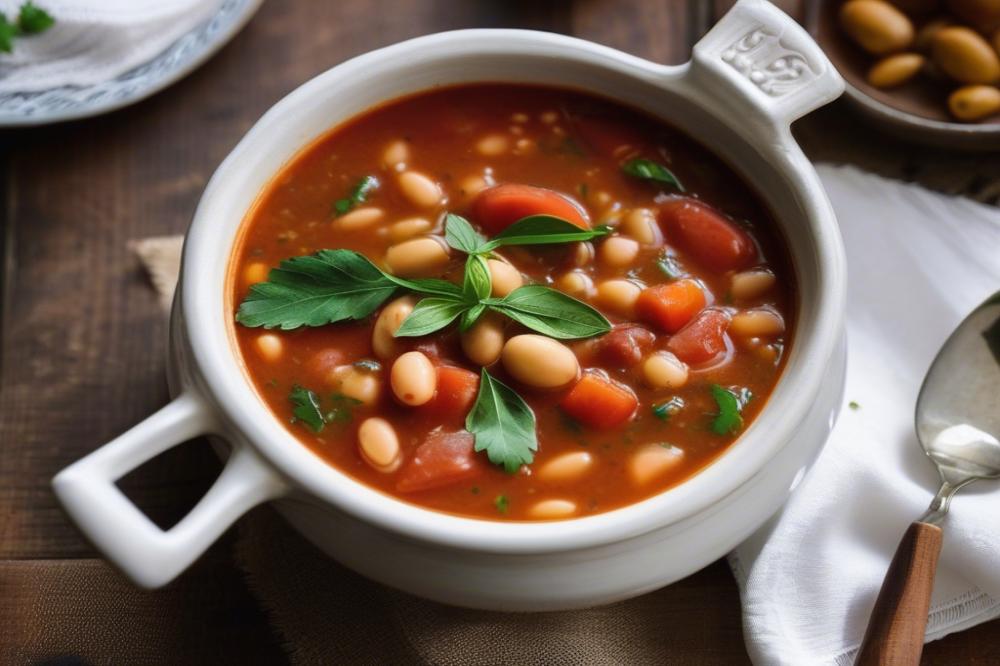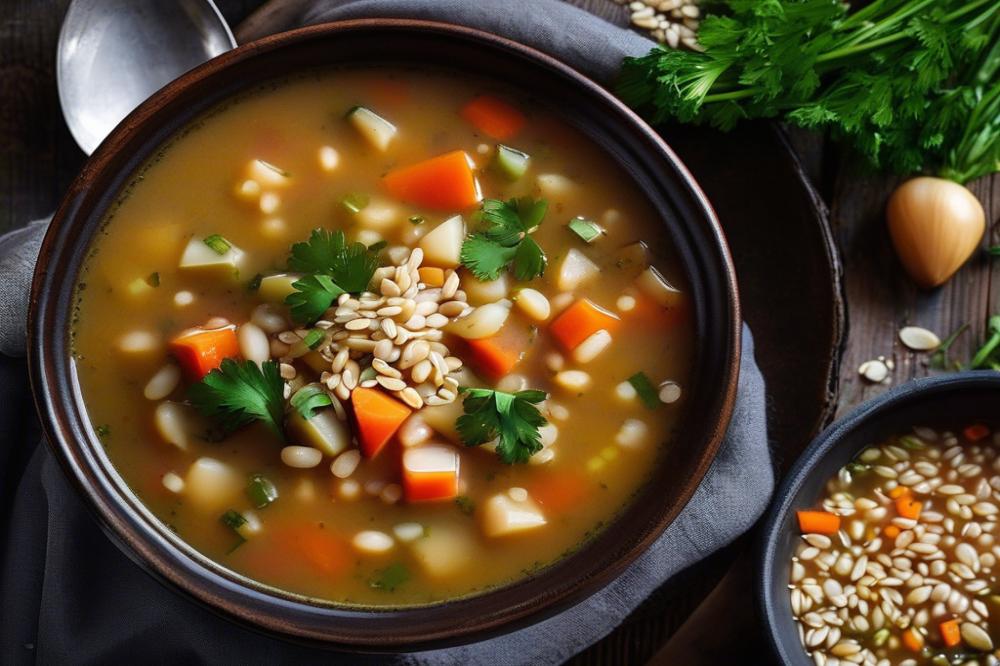Introduction
Greek cuisine stands out for its vibrant flavors and wholesome ingredients. This culinary tradition emphasizes fresh produce, herbs, and, most importantly, a commitment to healthy cooking. Within this rich landscape of food, classic dishes reflect the culture’s history and community. Among these, the Greek Bean Soup known as Fasolada holds a special place.
A traditional bean soup, Fasolada combines simple ingredients such as lentils, tomatoes, and olive oil. It is nourishing and perfect as a vegetarian soup. Families have enjoyed this dish for generations, not just as a meal but as a symbol of togetherness. Recipes for Fasolada can vary from home to home, yet they all share a common foundation of love and care.
The Mediterranean diet, recognized for its health benefits, features dishes like this soup prominently. Rich in protein and fiber, it makes a satisfying comfort food. Eating well does not require complexity; often, it is about choosing simple and nutritious ingredients. By indulging in recipes like this Greek Bean Soup, one embraces the principles of healthy eating while enjoying delicious flavors.
What is Fasolada?
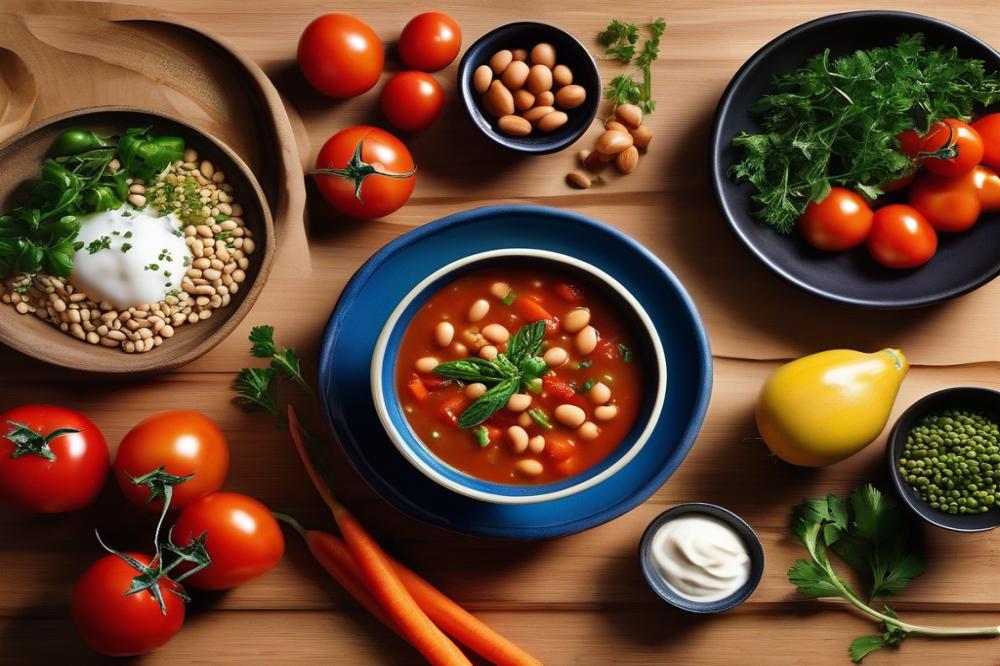
Historical background of Fasolada in Greek culture
Fasolada has deep roots in Greek culture, tracing back to ancient times. It is often referred to as the national soup of Greece. Historically, it was a dish that brought families together. During the lean months, beans were a popular food source. In fact, many people relied on legumes for nourishment. This soup symbolizes resilience and community. Farmers often made it using ingredients from their gardens. Its story reflects the heart of Greek cuisine.
Description of Fasolada as a vegetarian soup
This vegetarian soup is packed with flavor. Typically made with beans, tomatoes, and an array of vegetables, it offers hearty goodness. Olive oil adds richness to the dish, making it comforting. Each bowl is colorful, filled with vegetables that are both nutritious and delicious. Many recipes showcase the versatility of beans in Mediterranean cooking. Cooking this soup allows home chefs to enjoy a simple yet satisfying meal. It also caters to those seeking healthy recipes.
Importance of legumes in Greek diets
Legumes play a crucial role in Greek diets and health. They are packed with protein and fiber, making them an excellent food choice. Lentils, chickpeas, and beans are staples that contribute to a balanced eating pattern. Many Greek meals revolve around these ingredients, showcasing their importance in everyday life. Incorporating legumes into meals aligns well with the Mediterranean diet. Such a diet is linked to numerous health benefits. By including these foods, individuals support their overall well-being. Furthermore, recipes that highlight legumes are both economical and environmentally friendly.
Ingredients List and Measurements

Cooking a delicious Greek bean soup is simple with the right ingredients. Below is a detailed list along with quantities. Using fresh, quality items will elevate the flavors in this vegetarian soup. Here’s what you need:
- 1 cup dried cannellini beans – These beans are the star of the soup and provide protein and fiber.
- 4 cups vegetable broth – A rich liquid base makes the soup hearty. You can also use water in a pinch.
- 2 medium-sized tomatoes, diced – Fresh tomatoes provide natural sweetness and acidity to balance the dish.
- 1 large onion, chopped – This adds depth and flavor, making it an essential ingredient in many bean recipes.
- 2 cloves garlic, minced – Garlic enhances the taste and contributes to the health benefits of Greek cuisine.
- 1 carrot, diced – Carrots add a slight crunch and natural sweetness.
- 2 celery stalks, diced – Celery contributes a mild flavor and crunchy texture, completing the base of the soup.
- 1/4 cup olive oil – A staple in the Mediterranean diet, this will enrich your soup.
- 1 teaspoon dried oregano – This herb adds a fragrant aroma and complements the other ingredients.
- Salt and pepper to taste – Seasoning is key to bringing out the flavors in any dish.
Nutritional Information
The healthy cooking aspect of this recipe is highlighted by its nutritious components. Below are the nutritional values for each ingredient:
- Cannellini beans (1 cup): 225 calories, 15g protein, 1g fat, 40g carbohydrates
- Vegetable broth (4 cups): 40 calories, 4g protein, 0g fat, 8g carbohydrates
- Tomatoes (2 medium): 44 calories, 2g protein, 0g fat, 10g carbohydrates
- Onion (1 large): 60 calories, 1g protein, 0g fat, 14g carbohydrates
- Garlic (2 cloves): 9 calories, 0g protein, 0g fat, 2g carbohydrates
- Carrot (1 large): 30 calories, 1g protein, 0g fat, 7g carbohydrates
- Celery (2 stalks): 10 calories, 0g protein, 0g fat, 2g carbohydrates
- Olive oil (1/4 cup): 477 calories, 0g protein, 54g fat, 0g carbohydrates
- Oregano (1 teaspoon): 3 calories, 0g protein, 0g fat, 1g carbohydrates
Your soup becomes a healthy meal choice packed with essential nutrients. All of these ingredients work harmoniously to create a warm dish full of flavor. Each spoonful offers comfort and satisfaction, perfect for enjoying on chilly evenings. Try making this traditional recipe for a nourishing addition to your diet.
Cooking Instructions
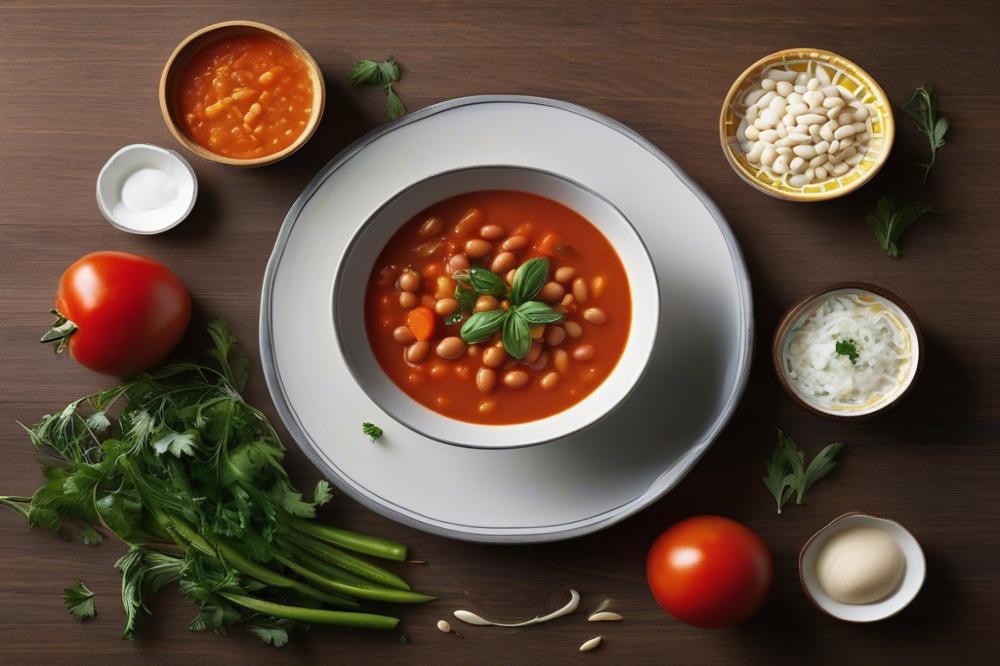
Preparation of Ingredients
First, gather all your ingredients. You will need dry beans, fresh vegetables, and herbs. Start with 1 cup of dry white beans. Rinse them well and remove any debris. Soaking overnight is best, but if you don’t have time, a quick boil for an hour will do. Chop one large onion, three carrots, and two celery stalks. These will build the base of flavor in your vegetarian soup. Wash two to three ripe tomatoes. If fresh tomatoes are not available, canned ones work just fine. Don’t forget the garlic; three cloves should suffice. Mince them for that comforting aroma.
Cooking Process
Heat about 1/4 cup of olive oil in a large pot over medium heat. Add the chopped onions, carrots, and celery once it’s hot. Stir occasionally for about five minutes until the veggies soften. Toss in the minced garlic and cook for another minute. The scent will make your mouth water!
Next, add the soaked or boiled beans into the pot. Pour in about 6 cups of vegetable broth. If you’re looking for a richer flavor, homemade is a great choice. Now, add the tomatoes, salt, and pepper to taste. Optional spices like bay leaves or oregano enhance the Mediterranean diet experience. Bring everything to a boil, then reduce the heat and let it simmer for about an hour. Keep an eye on it; stirring occasionally can prevent sticking.
Cooking time may vary, so check the beans for tenderness. If they’re ready, you’re almost done. To serve effectively, ladle the soup into bowls and drizzle additional olive oil on top for that extra richness. Fresh parsley can make your dish pop!
Feel free to explore variations. Lentils can be subbed for beans if you prefer a different texture. Serve this delightful dish with warm bread, perfect for soaking up the delicious broth. Enjoying this traditional recipe warms the heart and nurtures the body.
Variations of Fasolada
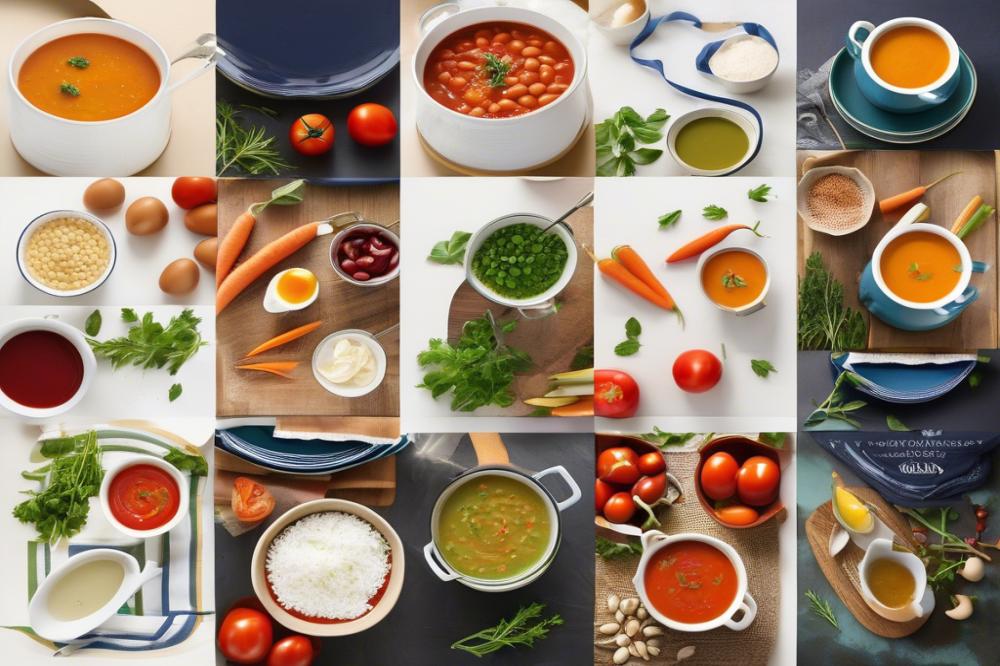
Different Regional Variations in Greece
Greek cuisine offers numerous interpretations of this beloved soup. Regions throughout Greece have their own twist on the traditional recipe. In coastal areas, you might find seafood elements added to the mix. In contrast, mountainous regions may focus on heartier ingredients like potatoes or wild greens. These variations showcase how versatile this vegetarian soup can be. Each locale brings its own flavor, enhancing the experience of enjoying a comforting bowl.
Possible Substitutions for Ingredients
There’s no need to stick rigidly to the recipe when making this dish. For example, if you can’t find specific beans, lentils work just as well. They provide a similar texture and still fit within the realm of bean recipes. Fresh tomatoes can be substituted with canned ones, especially when tomatoes are out of season. Additionally, switching out herbs can add new dimensions. If you have basil or oregano instead of parsley, feel free to use them. Such substitutions won’t compromise the overall essence.
Suggestions for Enhancing Flavors or Adding Protein
Enhancing the flavors of a classic soup is easier than you might think. A splash of balsamic vinegar can add depth to the dish. You might also consider sprinkling some crushed red pepper to give it a bit of kick. Adding a dollop of Greek yogurt on top serves as a delicious creamy contrast. For those seeking added protein in their meals, diced chicken or turkey can be included. If you prefer plant-based options, incorporating quinoa or chickpeas works beautifully with the Mediterranean diet. Drizzling high-quality olive oil at the end elevates the overall taste, making it a healthy and satisfying meal.
Fasolada and the Mediterranean Diet
Fasolada fits perfectly into the Mediterranean diet, which is known for its health benefits. This diet emphasizes fresh fruits, hearty vegetables, whole grains, and healthy fats. A vegetarian soup like fasolada provides essential nutrients while being delicious and satisfying. Being rich in beans, tomatoes, and olive oil, this dish serves as an excellent choice for those aiming to eat well.
Beans, the main ingredient in fasolada, are packed with protein and fiber. These nutrients promote a feeling of fullness, making it easier to maintain a healthy weight. Additionally, the variety of vegetables used adds vitamins and minerals. The use of olive oil contributes healthy fats that are beneficial for the heart. Lentils can also be an alternative in similar recipes, providing another nutritious option in this class of food.
Many bean recipes share the nutritious qualities of fasolada. While other cultures may have their unique takes on bean soups, Greek cuisine stands out with its use of fresh ingredients and bold flavors. For example, Italian minestrone or Mexican black bean soup offer different profiles but also emphasize the importance of legumes in healthy cooking. Each recipe brings comfort food to the table, yet fasolada remains distinct because of its simplicity and authenticity.
Choosing fasolada is not just about taste; it’s about embracing a lifestyle. The Mediterranean diet, in general, encourages balance and moderation. People who adopt this way of eating often report feeling energized and healthier overall. Traditional recipes like fasolada remind us of the importance of whole foods, making it not just a meal, but a step towards better well-being.
Serving Suggestions
Best Ways to Serve Fasolada
Fasolada is best enjoyed hot, straight from the pot. Bowls made of ceramic or clay add to the rustic charm of this classic Greek dish. A drizzle of high-quality olive oil elevates the flavors, creating a rich and inviting presentation. Serving this vegetarian soup with crusty bread makes for a comforting meal. Consider using a hearty sourdough or a fragrant ciabatta. You can also pair the soup with a side of olives for an authentic Mediterranean touch.
Accompaniments That Pair Well with the Soup
Try adding a fresh Greek salad on the side. The crisp vegetables and tangy feta cheese create a refreshing contrast to the soup’s warmth. Grilled vegetables also make a delightful addition, bringing a smoky flavor that complements the dish. If you prefer a heartier option, consider serving lentils alongside. Many people enjoy a slice of lemon to squeeze over the soup for a zesty kick. These simple side dishes enhance the overall meal experience, providing balance and variety.
Ideas for Garnishing and Enhancing Presentation
Garnishing plays an important role in presentation. Fresh parsley or basil can liven up the bowl with vibrant green color. A sprinkle of paprika adds not only visual appeal but also a subtle hint of flavor. For a touch of elegance, finely chopped red onion atop the soup can bring a crispness that contrasts beautifully with the soft beans. To make the meal even more inviting, serve with a small dish of toppings, like crumbled feta or extra olives. This encourages guests to personalize their bowls and enhances the communal experience of enjoying traditional recipes.
Final Thoughts on Cooking Greek Fasolada
Fasolada holds a special place in Greek cuisine. It is not just a simple vegetarian soup; it symbolizes the warmth and hospitality of Greek culture. This dish has been enjoyed for generations, often served during family gatherings or special occasions. Traditionally, it’s a comforting food that brings people together at the dinner table.
Making this soup at home can be a rewarding experience. Fresh ingredients meld together to create rich flavors that are hard to match. Preparing it yourself allows for creativity. You can experiment with different herbs and spices to align it with your taste. Don’t shy away from adding your personal touch!
The act of cooking is also tied to memories and family traditions. As you bring together the tomatoes, beans, and other vegetables, you’re also connecting to a part of history. Each bowl of fasolada serves as a reminder of home, warmth, and love. So, gather your ingredients and try making this comforting dish. You may discover a new favorite recipe that resonates with your heart and spirit.

